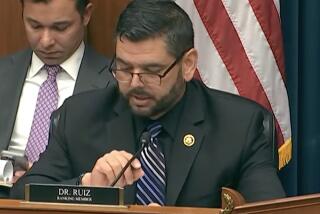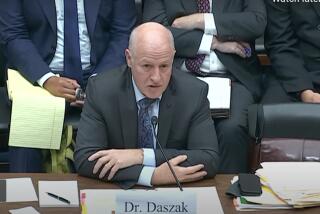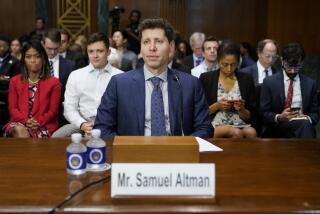Upgrade of faulty U.S. biodefense system opposed
Homeland Security Secretary Janet Napolitano’s top expert on anti-terrorism technology has privately advised her to spike a long-planned, multibillion-dollar upgrade of BioWatch, the nation’s troubled system for detecting a biological attack.
Dr. Tara O’Toole, the department’s undersecretary for science and technology, doubts that the so-called Generation 3 version of BioWatch could be relied on to detect anthrax, smallpox, plague or other deadly germs in the event of a biological attack, scientists familiar with the matter said.
O’Toole is also concerned that the cost of the upgrade -- $3.1 billion for the initial five years -- would divert money from measures she considers more beneficial, such as establishing computer links between hospitals, large HMOs and public health agencies to speed the distribution of medicine after an attack, the scientists said.
O’Toole, a physician and presidential appointee, has voiced her opinion to department scientists and directly to Napolitano, according to people familiar with the matter.
“Her position is, ‘Kill it,’ ” said a federal scientist with knowledge of O’Toole’s discussions about Generation 3. The scientist and others interviewed spoke on condition of anonymity because they were not authorized to comment on BioWatch.
Napolitano has been weighing whether to approve plans for the five-year Generation 3 contract. Some officials within the Homeland Security Department want to go ahead with the upgrade, and private contractors, notably Northrop Grumman Corp., say they are eager to build the new system. Napolitano has given no public indication how she will decide.
O’Toole referred a request for an interview to Homeland Security’s chief spokesman, Matthew Chandler. He said O’Toole would not be permitted to be interviewed. He declined to say why.
The chairmen of the House Energy and Commerce Committee and its investigative subcommittee have asked the Homeland Security Department for emails or minutes of meetings reflecting O’Toole’s views on BioWatch. The department, citing a desire to keep internal deliberations confidential, has denied congressional investigators access to the documents, federal officials said.
The committee leaders made their request in response to a July 8 article in the Los Angeles Times about deficiencies in BioWatch, including prototypes for Generation 3.
President George W. Bush unveiled BioWatch during his 2003 State of the Union address, saying it would provide “the nation’s first early-warning network of sensors to detect a biological attack.”
In more than 30 major cities, BioWatch units placed atop buildings and in other public places suck air through composite filters around the clock. The filters are removed daily and delivered to public health laboratories, where technicians search for the DNA of anthrax, smallpox and a handful of other pathogens.
Repeated false alarms have soured many state and local public health officials on the system. A September report by the Government Accountability Office, an investigative arm of Congress, said there had been more than 100.
The alarms have triggered tense, high-stakes deliberations over whether to order mass evacuations, distribute emergency medicine or shut down major venues. In each case, health authorities decided, sometimes with great trepidation, to disregard BioWatch.
No evidence of an intentional release of a pathogen has ever been found.
The false alarms stem from BioWatch’s inability to distinguish between harmful pathogens and genetically similar but benign organisms that are abundant in the environment, according to scientists who have worked with the system.
In the Generation 3 version of BioWatch, automated “lab in a box” units would sift the air and report findings electronically. In theory, Generation 3 could detect an attack in four to six hours -- compared with 12 to 36 hours with the present system.
That would enable authorities to dispense emergency medicine more quickly after an attack. It could also reduce costs because fewer laboratory personnel would be needed, say proponents of the automated technology.
But lab and field tests have found that Generation 3 prototypes were neither durable nor sensitive enough to reliably detect an attack.
O’Toole has supervised scientists responsible for tracking the testing of Generation 3 prototypes at the Army’s Dugway Proving Ground in Utah, at the Pacific Northwest National Laboratory in Washington state and in Chicago and the New York City subways.
In Chicago, the units could not function for more than a week at a time without maintenance -- although the goal is for the units to operate autonomously for at least a month.
In New York, the prototypes repeatedly generated false readings, prompting officials there to demand their removal.
The tests in Utah and Washington found that the automated units could detect a pathogen only if exposed to concentrations far exceeding the levels that can sicken or kill.
Before President Obama nominated her in 2009 to be a Homeland Security Department undersecretary, O’Toole studied BioWatch as the founder and chief executive of the University of Pittsburgh’s Center for Biosecurity. She told a House Homeland Security subcommittee on March 29, 2007, that “different and more useful” biodefense spending was needed to protect the nation.
Building digital links among hospitals, HMOs and local public health agencies “would be far more cost-effective than funds spent on future generations of BioWatch,” she testified.
Though she has not spoken publicly for or against Generation 3 since joining the Obama administration, O’Toole told the same House subcommittee on Feb. 25, 2010, that it was “imperative” that the automated system “be carefully evaluated and ... tested in realistic field conditions before large technology acquisition investments are made.”
O’Toole said scientists under her supervision would “continue to work collaboratively to conduct and oversee rigorous developmental and operational tests of the proposed Gen 3.”
Her reservations notwithstanding, enthusiasm for Generation 3 has persisted within the Homeland Security Department. On March 29, the department’s chief medical officer, Dr. Alexander Garza, told a House subcommittee that deploying Generation 3 would be “imperative to saving lives.”
On Sept. 13, Garza told a congressional hearing that the department would not follow the Government Accountability Office’s recommendation to halt contracting activities for Generation 3 so the technology and potential alternatives could be reassessed.
Chandler, the Homeland Security spokesman, said a unit headed by Garza would “pursue rigorous operational testing and evaluation of candidate Generation 3 technologies to make an informed decision before deployment.”
--
More to Read
Sign up for Essential California
The most important California stories and recommendations in your inbox every morning.
You may occasionally receive promotional content from the Los Angeles Times.











